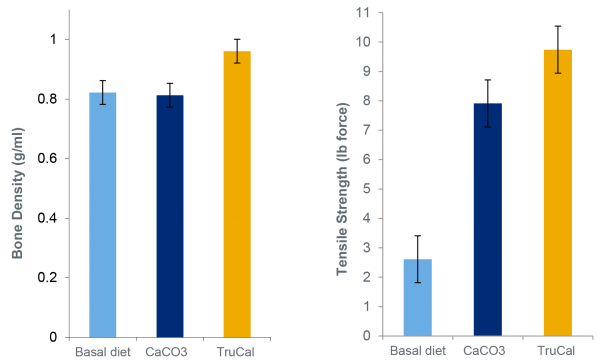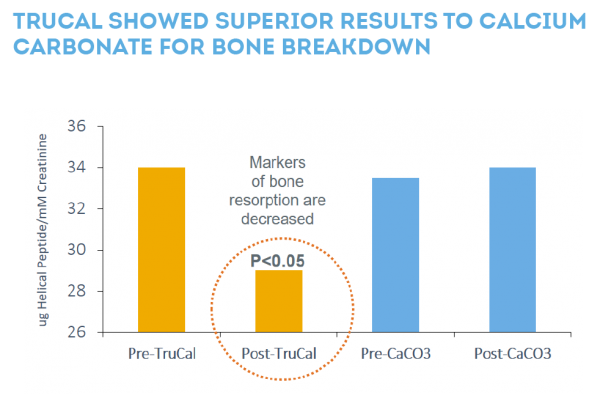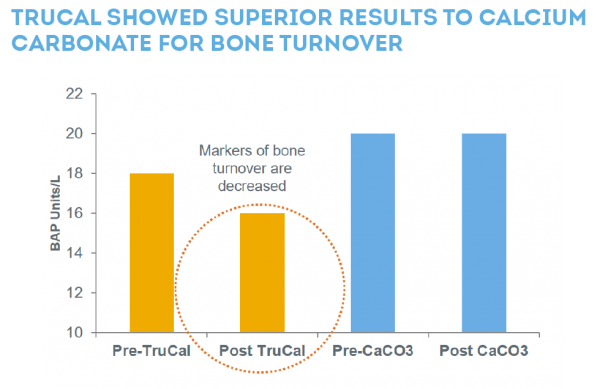Promotional Features
Much More Than Just Calcium – Balanced Minerals for Superior Bone Health
With steady single digit growth in volume of calcium in nutrition1 and an irrefutable reputation as one of the most important nutrients for our general health, calcium continues to be a major dietary focus for consumers of all ages. As the calcium product market continues to grow, regional reports and buying trends prove that consumers are keen to find calcium in food and beverages. Associated with many health benefits, some consumers recognize the difficulty in meeting their recommended daily intake. While calcium raw ingredient sales for nutrition is looking at small yoy growth in North America (0.6% CAGR projected), the U.S. still makes up 21% of the global calcium ingredient market for nutrition1. Further, 48% of U.S. consumers are willing or extremely willing to pay a premium for products that contain calcium2 with 20% age 55-70 actively seeking bone health products3.
As focus continues to center on the importance of a calcium-rich diet and the difficulty consumers report on meeting their dietary calcium goals, the calcium supplement market is poised for a steady 1-2% projected annual growth globally1.
Why Calcium Alone Won’t Cut It
Over a lifetime, bone development and preservation involves a complex and dynamic process in which bone is constantly breaking down and rebuilding through a natural self-repair process known as remodeling. As a living tissue, bone mass density will change over the course of a lifespan, with primary prevention set to target maximizing peak bone mass during the formative years and secondary prevention directed towards minimizing bone loss that comes with age and hormonal changes. Due to the complexity and oscillating nature of bone tissue management, bone development and preservation involves a sensitive balance of nutrients that span beyond calcium alone.
Breaking down the natural composition of bone, you’ll find a combination of calcium, phosphorus, magnesium, potassium, zinc, and copper. Each of these nutrients plays an important role when it comes to maintaining optimum bone health.
The Role of Calcium
Making up about 25% of total mineral composition in healthy bone tissue, calcium is vital for bone health. With 99% stored in bones and teeth, calcium plays an integral role in bone health and general wellness. By binding to blood proteins to form enzymes, which are involved in metabolism and muscle tissue function, calcium is a necessary part of human performance and function4. When dietary calcium intake slips, the mineral is stripped from the bones to support necessary physiological processes, thus initiating a cycle of bone demineralization.
To combat adulthood and geriatric bone loss, calcium intake must be prioritized during childhood and adolescent years. One study examining the impact of physical activity and calcium consumption in children found that when paired with increased physical activity, a higher daily calcium intake led to higher bone mineral content, size, and density5.
The Additional Pieces to the Bone Health Puzzle
As the second most concentrated mineral in bone, it might surprise some to learn that when it comes to phosphorus, more does not equate to better for optimizing bone health. When phosphorus intake is increased in the absence of higher calcium consumption, individuals run an increased risk for developing bone fractures and osteoporosis. However, research indicates that a subsequent increase in both minerals simultaneously does contribute to total bone health. In fact, study findings have revealed that when adolescent and adult subjects increased phosphorus consumption while consuming an appropriate intake of calcium, they experienced an increase in bone mineral content and density while lowering their risk for developing osteoporosis6,7,8. These findings support the need for the addition of other trace minerals when developing an effective supplement to support bone health.
Rounding out the top three most abundant minerals in bone is magnesium, which plays a critical role in bone health and is involved in both energy production and the regulation of total circulating calcium. As with phosphorus, a specific ratio of magnesium and calcium is necessary to achieve adequate bone mineral density levels while reducing the possibility of fractures, a main concern for post-menopausal women. One study examining the concentration of blood and bone magnesium in older women suffering from osteoporosis found that supplementation with the mineral improved their performance in physical strength assessments, which was attributed to enhanced bone health and total bone density, further indicating the need to go beyond calcium supplementation alone9.
Other research focusing on bone tissue management has sought to compare supplementation of calcium, trace minerals, or a combination of both. Following a two year double-blind study with post-menopausal women, research revealed that neither calcium nor trace mineral supplementation alone matched the bone health benefits of the combination of both. Only subjects prescribed both a calcium and trace mineral supplement showed a reversal in bone mineral density loss, confirming the notion that calcium alone is not enough10.
Not All Calcium Sources Deliver the Same Benefits
With the rise in dairy alternatives and prevalence of subpar calcium supplements like mineral-derived calcium carbonate, some might be surprised to learn that not all calcium sources are created equal. These other forms lack the additional essential minerals necessary to support bone health.
Studies have found that when compared to children who got their calcium from alternative sources to cow's milk, those who consumed dairy products had a lower BMI and higher bone mineral content and density. Researchers concluded that the difference in outcomes was due to the multi-mineral balance that is only obtainable through the consumption of dairy-milk and dairy milk alone.
TruCal®: A Balanced Formula for Better Bone Health
Using the composition of natural dairy milk, Glanbia Nutritionals has developed TruCal, a premium milk mineral complex that offers the precise balance of nutrients necessary to promote bone health and longevity. Combining seven essential minerals derived directly from cow’s milk, TruCal delivers a precise combination of micronutrients that mirrors the mineral composition of bone tissue itself.
In an animal study, TruCal was compared to calcium carbonate and a standard diet to examine the effects each supplement had on bone density and strength during periods of rapid growth. Each group received a standardized breakdown of all extraneous macro and micronutrients to control for external variables. Despite offering an identical concentration of calcium as calcium carbonate, the group administered TruCal showed increased bone strength and density compared to all other subgroups examined11.
Another study using human subjects examined twenty female participants who were administered 700mg of calcium from either TruCal or calcium carbonate. Urine Helical Peptide (UHP), an indicator of bone breakdown, and Bone Alkaline Phosphatase (BAP), a bio-marker reflecting the activity of bone-forming cells, were measured. After six weeks, the results from the study revealed that TruCal was in fact superior to calcium carbonate supplementation for supporting maximum bone health and preservation. The subjects who received TruCal during the course of the trial had lower levels of both UHP, indicating a reduction in bone tissue breakdown and reabsorption, and decreased levels of circulating BAP, reflecting a lower level of bone turnover11.
The Next Generation of Bone Health Support
Calcium supplementation continues to dominate the nutraceutical space as consumer interest and awareness centers on the lifelong challenges associated with managing and maintaining optimal bone health. TruCal was designed to speak to this demand by offering a product that mimics the mineral profile of bone. With the ability to go into a wide range of applications, TruCal offers the versatility and evidence-based health benefits to elevate bone health focused supplement products to the next level.
See how TruCal can benefit your bone health formulations.
-------
References:
- Euromonitor – August 2020 – Forecasted data 2020
- FMCG Gurus, Insights & Opportunities in Global Joint & Bone Health, January 2019
- Glanbia Nutritionals Supplement Survey, May 2019
- Journal of Bone and Mineral Research, vol. 11, no. 12, 1996, doi:10.1002/jbmr.v11:12.
- Osteoporos Int. 2012 Jan; 23(1): 121–130.
- J Bone Miner Res. 1996;11:1905–12.
- J Nutr. 1978;108:447–57.
- Lee et al. (2015) Nutr J 14(1): 28
- Am J Clin Nutr, 2014;99:926–33.
- Strause, Linda, et al. “Spinal Bone Loss in Postmenopausal Women Supplemented with Calcium and Trace Minerals.” The Journal of Nutrition, vol. 124, no. 7, 1994, pp. 1060–1064., doi:10.1093/jn/124.7.1060.
- Glanbia Study. Data on file.







